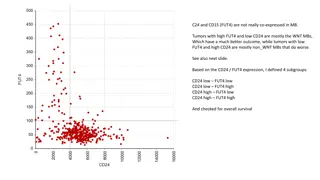MalignantTumors of Intestine
This lecture discusses the epidemiology, pathology, and prognosis of malignant tumors of the intestine, with a focus on colon cancer. It covers the different stages of colorectal adenocarcinoma, the relationship between CEA and recurrence, and the significance of carcinoid tumors.
4 views • 40 slides
Zongertinib Trial in HER2 Aberrant Tumors
Zongertinib (BI.1810631) Phase I Study in Advanced Solid Tumors with HER2 Aberrations focusing on NSCLC. The trial involves dose escalation and expansion, testing different doses in cohorts with varied HER2 mutations. Primary endpoints include MTD, OR, and DLTs.
2 views • 14 slides
Understanding Liver Function Tests in Cholestatic Injury
Cholestatic liver disease affects Alkaline Phosphatase (ALP) and bilirubin levels, indicating bile duct damage. GGT and 5'-Nucleotidase help differentiate hepatobiliary vs. bone origin of ALP elevation. ALP is produced by bile duct epithelium and can be normal in acute biliary obstruction. GGT and N
1 views • 33 slides
Understanding Tumor Classification and Nomenclature in Pathology
This slideshow provides an overview of tumor classification, nomenclature, and key concepts in pathology. It covers the definitions of neoplasm, tumor, and oncology, the classification of tumors into benign and malignant categories, as well as the importance of stroma in tumor behavior. It also expl
4 views • 61 slides
HER2 Tyrosine Kinase Inhibitor Zongertinib Phase Ia/b Trial in Solid Tumors
Study on Zongertinib, a HER2 tyrosine kinase inhibitor, in patients with HER2 aberration-positive solid tumors. The trial involves multiple centers worldwide and aims to evaluate the efficacy of Zongertinib in treating various cancers harboring HER2 mutations. Financial disclosures of lead investiga
1 views • 13 slides
Understanding Neurogenic Speech and Language Disorders in Adults
This chapter provides insight into language disorders in adults, including types of aphasia, causes such as toxins, traumatic brain injury, brain tumors, and strokes. It discusses cerebral hemorrhage, occlusive strokes, ischemic stroke, transient ischemic attacks, and cerebral thrombosis. The conten
1 views • 34 slides
Pituitary Disorders
Pituitary disorders, often caused by tumors, can disrupt hormone production leading to various symptoms like weight gain, vision problems, and hormonal imbalances. The pituitary gland plays a crucial role in regulating bodily functions through hormone secretion. Factors such as tumor growth, head in
0 views • 25 slides
Understanding No Enveloped DNA Viruses: Papillomaviruses and Polyomaviruses
Explore the characteristics and implications of no enveloped DNA viruses, such as Papillomaviruses causing common warts and Polyomaviruses inducing tumors in animals. Learn about their genetic properties, potential for carcinogenesis, and infections in different host systems.
6 views • 18 slides
best neurosurgeon doctor in jaipur
Dr. Himanshu Gupta is Jaipur's top neurosurgeon, renowned for his exceptional care and surgical expertise. With extensive training, he specializes in treating various neurological conditions, including brain tumors and spinal disorders. Dr. Gupta's compassionate approach fosters strong doctor-patien
6 views • 6 slides
Bone Marrow Transplant Cost in India
The supple, fatty tissue found inside your bones is called bone marrow. The cells that make blood and platelets are found in bone marrow, which also produces billions of new blood cells daily.\nA bone marrow transplant (BMT) includes using healthy blood-forming stem cells to replace the patients' di
1 views • 2 slides
_Best Neurosurgeon Doctor In Jaipur || Dr Himanshu Gupta || drhimanshugupta.com
Dr. Himanshu Gupta is known not only for his mastery of surgical techniques, particularly in microsurgery and Endosurgery for brain tumors but also for his exceptional skills in managing patients requiring trauma, brain, and spine surgeries.\n\nHis focus lies in exclusive neurosurgery, making him a
0 views • 7 slides
Best Prostate Cancer Treatment Hospitals in India
The prostate is a soft organ in reproductive anatomy. It is nearly about the size of a chestnut. Its weight is around 30 grams. It is located in the pelvis below the bladder with the urethra passing through. It is surrounded by an elastic, fibromuscular capsule and contains glandular tissue and conn
1 views • 2 slides
Biomarkers Market Trend to be Worth $201.33 Billion by 2031
Biomarkers are either released by the human body in response to various diseases or by organs that are affected by the disease, such as tumors. Biomarkers are being used increasingly to detect several infectious and chronic diseases, such as cancer, neurological disorders, cardiovascular diseases, a
1 views • 2 slides
neurosurgeon in jaipur-Dr Himanshu Gupta
brain tumor is an abnormal growth of cells in the brain. Tumors can be either cancerous (malignant) or non-cancerous (benign). Cancerous tumors grow and spread aggressively, potentially invading nearby tissues and spreading to other parts of the body, while non-cancerous tumors are usually less aggr
0 views • 5 slides
Detailed Anatomy Review for GIT Blood Supply
This content provides a thorough anatomy revision focusing on the blood supply of the gastrointestinal tract (GIT). It covers stations discussing the blood supply of the stomach, complications during cholecystectomy, perforated duodenal ulcer scenarios, pancreatic tumors, and structures related to m
0 views • 15 slides
Understanding Testicular Tumors: Types, Classification, and Clinical Findings
Testicular tumors are predominantly malignant, with germ cell tumors being the most common type. This article delves into the classification of testicular tumors, including primary and secondary, benign and malignant, germ cell, and non-germ cell tumors. Clinical findings such as painless enlargemen
3 views • 31 slides
Understanding Grading and Staging of Malignant Tumors in Cancer Patients
Grading and staging are crucial in determining the aggressiveness and extent of malignant tumors. Grading involves assessing the level of malignancy based on cell differentiation and mitotic activity, while staging considers the size of the tumor, lymph node involvement, and presence of metastases.
7 views • 31 slides
Comprehensive Overview of Parotid Tumor Diagnosis and Management
This comprehensive guide covers the diagnosis and management of parotid tumors, including anatomy, differential diagnosis, and management strategies. It discusses the approach to evaluating patients with neck lumps, differential diagnoses to consider, and the management techniques for both benign an
0 views • 20 slides
Understanding Gamma Knife Stereotactic Radiosurgery
The Gamma Knife Stereotactic Radiosurgery is a precise and effective treatment method where highly focused radiation beams are used to target tumors and abnormalities in the brain. It does not remove the tumor directly but affects DNA, cell growth, and blood vessels. The procedure involves three mai
0 views • 51 slides
Understanding Neuroendocrine Tumors: Endocrinology Insights
Delve into the complex world of neuroendocrine tumors (NETs) through a detailed presentation prepared by Dr. Thomas O'Dorisio from the University of Iowa. Explore case reports, therapeutic interventions, and the challenges associated with managing these tumors. Gain valuable insights into the functi
0 views • 24 slides
Veterinary Dental Conditions and Tumors: A Comprehensive Overview
This detailed information covers various dental affections and tumors in veterinary medicine, discussing conditions like dental fistula, odontoma, ameloblastoma, and epulis. It provides insights into the causes, characteristics, and classifications of these oral health issues, offering valuable know
0 views • 9 slides
Understanding Neoplasia: Characteristics and Nomenclature of Tumors
Neoplasia, or new growth, is characterized by uncoordinated growth exceeding that of normal tissues, persistent growth independent of stimuli, loss of responsiveness to growth controls, and local expansion regardless of host environment. Tumors are classified into benign and malignant categories in
0 views • 36 slides
Histiocytic Neoplasia in the Heart: A Rare Case Report
A 3-year-old girl presented with persistent fever, leading to the discovery of a cardiac mass diagnosed as histiocytic neoplasia through imaging and biopsy. Primary cardiac tumors are rare in children, with benign tumors being more common. Histiocytic sarcomas are malignant neoplasms with characteri
0 views • 10 slides
Classification of Tumors: A Comprehensive Overview
Understanding the classification of tumors is crucial in the field of pathology. This detailed overview covers the definitions of neoplasia and tumors, the differentiation between benign and malignant tumors, nomenclature, and characteristics of various tumor types. It discusses the behaviors of ben
1 views • 34 slides
Understanding Pancreatic Cancer: Facts, Tumors, and Risk Factors
Pancreatic cancer, a deadly disease, is on the rise with specific risk factors like age, genetics, and lifestyle choices. Exocrine and endocrine tumors differ in presentation and treatment. Learn about the pancreas's location, statistics, and crucial risk factors associated with this malignancy.
0 views • 19 slides
Understanding PET-CT Imaging in Adrenal Tumors at Tehran University
Tehran University of Medical Sciences' Research Center for Nuclear Medicine specializes in PET-CT imaging for adrenal tumors. Dr. Arman Hassanzadeh-Rad, MD, explains the principles of PET imaging, hybrid imaging combining PET and CT, F-18 FDG use, SUV measurement, and more. PET-CT allows for both at
0 views • 21 slides
Epidemiology and Pathology of Brain Tumors - Overview and Incidence Statistics
This information provides an in-depth overview of the epidemiology, classification, and pathology of brain tumors. It covers the relative incidence of various brain tumors, including astrocytoma, glioblastoma, meningioma, and others. The data also includes statistics on the occurrence of brain tumor
0 views • 98 slides
Understanding Ear Tumors and Cholesteatoma: Causes, Symptoms, and Management
Ear tumors such as Glomus tumor and Acoustic neuroma can affect vital functions of the ear, leading to symptoms like tinnitus, vertigo, hearing loss, and facial nerve disorders. Surgical excision is a common treatment method. Cholesteatoma, an abnormal skin growth in the middle ear, can also cause c
0 views • 13 slides
Evaluation of MURR Thermal BNCT Facility for Canine Nasal/Sinus Tumor Treatment
The study evaluates the MURR Thermal BNCT Facility's effectiveness in treating canine nasal/sinus tumors using a phantom. The facility, located at the University of Missouri Research Reactor, offers Boron Neutron Capture Therapy (BNCT) under the direction of Dr. Fred Hawthorne. Key features include
0 views • 21 slides
Understanding Neoplasia and Odontogenic Tumors in Dentistry
Neoplasia refers to abnormal tissue growth surpassing normal growth, persisting excessively even after the initial stimulus. Odontogenic tumors are classified by the WHO in 1992 into benign and malignant categories, with various subtypes described. Ameloblastoma is a true neoplasm of enamel organ ti
0 views • 7 slides
Understanding Cancer Predispositions and Genetics in Pediatric Patients
Exploring cancer predisposition syndromes, basic genetics, and vocabulary related to pediatric cancer risk factors. Topics include CNS tumors, solid tumors, leukemia, hereditary retinoblastoma, and genetic testing guidelines for children with cancer predispositions.
0 views • 36 slides
Overview of Salivary Gland Tumors and Diseases
Salivary gland diseases, including tumors, can affect both major and minor glands. These tumors may be benign or malignant, with common benign tumors like pleomorphic adenoma. Clinical features of salivary gland tumors vary, with slow-growing benign tumors being more common. Pleomorphic adenoma is p
0 views • 27 slides
Understanding Brain Tumors: Classification, Clinical Features & Prognosis
Brain tumors, whether primary or secondary, present with various clinical features such as neurological deficits, seizures, and raised intracranial pressure. The classification includes common types like gliomas, meningiomas, and medulloblastomas. Astrocytomas are the most common primary intracrania
0 views • 22 slides
Expression Patterns of CD24 and FUT4 in Medulloblastoma
CD24 and FUT4 show distinct expression patterns in medulloblastoma, impacting tumor subtypes and patient outcomes. Tumors with high FUT4 and low CD24 are associated with favorable WNT subtype and better survival, while tumors with low FUT4 and high CD24 tend to have a poorer prognosis. Subgroups bas
0 views • 4 slides
Overview of Renal Tumors: Benign and Malignant Forms
Explore the spectrum of renal tumors, from benign papillary adenomas and oncocytomas to malignant renal cell carcinomas like clear cell carcinoma. Images and descriptions showcase the gross pathology and histopathology of these tumors. Learn about the features and prognosis of different renal tumor
0 views • 31 slides
Thymic Neuroendocrine Tumors: Demographics, Treatment, and Survival Study
This study presents an analysis of thymic neuroendocrine tumors (TNET) focusing on demographics, treatment, and survival outcomes. Conducted as a retrospective cohort study using the NCDB data from 2004 to 2015, the study aimed to examine the characteristics of TNET in terms of demographics, clinica
0 views • 16 slides
Intracranial Gliomas: Radiology, Diagnosis, and Management Overview
This comprehensive overview covers the classification, subtypes, and spatial definitions of intracranial gliomas, including astrocytic tumors, oligodendrogliomas, ependymal tumors, neuronal tumors, pineal tumors, and embryonal tumors. It also discusses low-grade gliomas and spatial definitions based
0 views • 38 slides
Neurosurgical Oncology A Complex Field of Cancer Treatment
Neurosurgical oncology is a specialized field of medicine that focuses on the surgical treatment of brain and spinal cord tumors. These tumors can be benign (non-cancerous) or malignant (cancerous), and their location and type can significantly impac
0 views • 3 slides
Neurosurgical Oncology A Complex Field of Cancer Treatment
Neurosurgical oncology is a specialized field of medicine that focuses on the surgical treatment of brain and spinal cord tumors. These tumors can be benign (non-cancerous) or malignant (cancerous), and their location and type can significantly impac
0 views • 3 slides
Symptomatic Control of Functioning Pancreatic NET
Pancreatic neuroendocrine tumors (panNETs) can be classified as functioning or non-functioning, with functioning tumors producing active hormones such as insulin, glucagon, gastrin, or VIP. Symptomatic control is crucial for managing these tumors, with diagnoses based on clinical syndromes and hormo
0 views • 19 slides







































